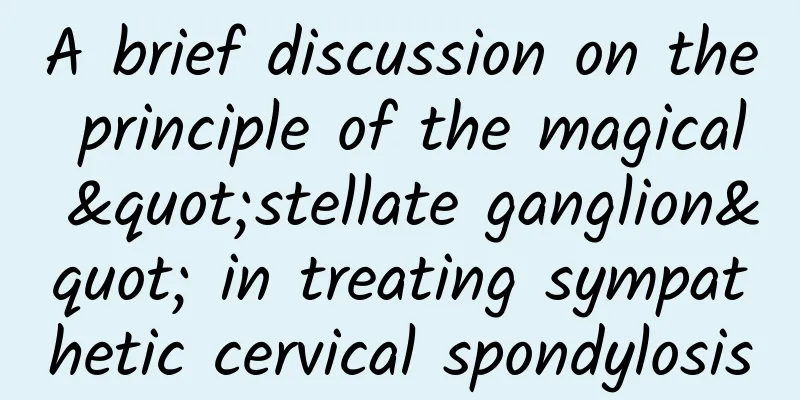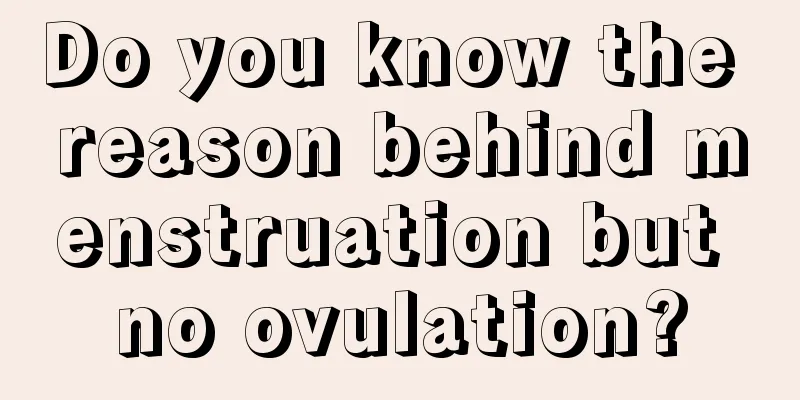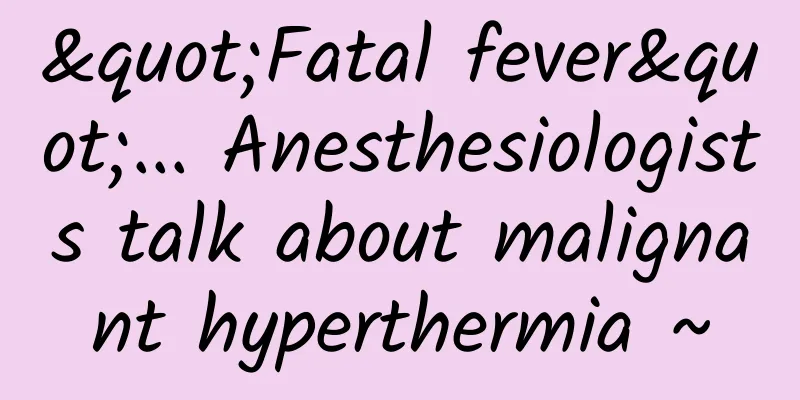A brief discussion on the principle of the magical "stellate ganglion" in treating sympathetic cervical spondylosis

|
In recent years, the number of people suffering from cervical spondylosis has been increasing year by year, which may be related to the popularization of computers, the accelerated pace of society, and the long hours of "head-down tribe" working at their desks. When you experience occipital pain, dizziness, tinnitus, blurred vision, anxiety, depression, memory and cognitive disorders, and pseudo-angina, you need to be alert to the possibility of sympathetic cervical spondylosis. Ms. Wang, 36 years old, is a mother who has suffered from neck and shoulder pain for more than a year. She just gave birth to her second child two months ago. Recently, her neck and shoulder pain has worsened, as well as paroxysmal chest pain, accompanied by dizziness, palpitations, chest tightness, and occasional nausea. The fatigue of taking care of the child for two months made her even more worried and anxious. Her family was worried that she had "postpartum depression". She visited several clinics of our hospital for a series of examinations on the brain, cervical spine, heart, etc., but no obvious abnormalities were found. The effect of psychological counseling and drug treatment was not significant. Finally, she was introduced by a cardiologist to come to the outpatient clinic of Director Zhang Zhili of the Pain Department of Qinhuangdao First Hospital. After a careful physical examination by Director Zhang and combined with previous auxiliary examinations, other internal diseases were ruled out and sympathetic cervical spondylosis was considered. Sympathetic cervical spondylosis is a series of clinical symptoms caused by various structural lesions of the cervical spine stimulating the sympathetic nerves, including occipital pain, nystagmus when the head moves, tinnitus, blurred vision, and corneal hyperesthesia. Other symptoms include anxiety, depression, and memory and cognitive disorders. Because the affected parts are extremely complex, it is extremely difficult to diagnose clinically and needs to be differentiated from a series of internal medicine diseases. It is also a disease that is easily misdiagnosed clinically. After research, Director Zhang Zhili's team diagnosed Ms. Wang with sympathetic cervical spondylosis, and the first step of the treatment plan was to perform ultrasound-guided stellate ganglion block. Stellate ganglion block is a minimally invasive treatment method commonly used in the pain department. It is a reversible block of the sympathetic nerves that control the head, face, neck, upper limbs and upper chest by injecting local anesthetics and other drugs into the loose connective tissue containing the stellate ganglion. The operation is simple and easy to perform using ultrasound guidance. It has the advantages of correctly selecting the puncture point, shortening the puncture time, accurately controlling the depth of the needle, improving the success rate of the puncture, and avoiding blind puncture to damage adjacent important organs. It not only improves the success rate but also reduces complications. The sign of a successful block is the appearance of Horner syndrome, which manifests as pupil constriction, ptosis, sunken eyeballs, nasal congestion, conjunctival congestion, slightly red face, and no sweat on the face. After several treatments, Ms. Wang's symptoms of neck and shoulder pain, chest pain and tightness, palpitations, and restlessness were basically relieved. In the second step, in order to consolidate and maintain the treatment effect, Ms. Wang received "green" neuromodulation treatment of pulsed high-voltage radiofrequency modulation of the stellate ganglion under ultrasound guidance. Pulsed radiofrequency is a neuromodulation technology that uses pulsed current below 42°C on the target nerves to avoid dependence on temperature damage and prevent nerve damage. This method can effectively improve the patient's vertebral artery blood flow and clinical symptoms and reduce the patient's pain level. After treatment, the symptoms that had troubled Ms. Wang for a long time were finally relieved, and she was discharged from the hospital with satisfaction! The magical stellate ganglion block is not only an effective treatment for sympathetic cervical spondylosis, but also has a wide range of applications and significant effects, including: 1. Systemic diseases: autonomic dysfunction, insomnia, hyperhidrosis, vertigo, skin itching, post-stroke pain, post-herpetic pain, chronic fatigue syndrome, phantom limb pain, diabetes, etc. 2. Head and facial diseases: migraine, tension headache, cerebral thrombosis, cerebral vasospasm, cerebral infarction, nerve paralysis, atypical facial pain, etc. 3. Eye and ENT diseases: floaters, visual fatigue, allergic rhinitis, Meniere's disease, benign paroxysmal vertigo, tinnitus, etc. 5. Respiratory and circulatory system diseases: angina pectoris, sinus tachycardia, cardiac neurosis, chronic bronchitis, pulmonary embolism, bronchial asthma, etc. 6. Digestive system diseases: ulcerative colitis, gastritis, gastric ulcer, intestinal obstruction, constipation, diarrhea, etc. 7. Urinary and reproductive system diseases: abnormal menstruation, premenstrual tension disorder, menopausal syndrome, neurogenic urinary frequency, nocturia, urinary incontinence, prostatitis, etc. 8. Diseases of the body and limbs: cervical spondylosis, cervical-shoulder-arm syndrome, periarthritis of the shoulder, redness, swelling and pain in the extremities, cyanosis, thromboangiitis obliterans, bone hyperplasia, degenerative osteoarthritis, low back pain, etc. It should be noted that stellate ganglion block is risky and requires evaluation by an experienced pain specialist before it can be performed. Pain is a disease. Pain specialists specialize in treating various stubborn pains that are not effectively treated by other departments. They analyze the causes and mechanisms of pain, and provide medication, nerve block therapy, various nerve regulation and nerve destruction and other minimally invasive interventional surgeries. They also provide psychological intervention when necessary. Through comprehensive treatment, they effectively relieve symptoms and improve the quality of life. |
<<: How much do you know about the causes and treatments of cervical spondylosis?
>>: Hepatitis B vaccination for children: protecting children's health
Recommend
How many days is it normal to delay menstruation?
We all know that the menstrual cycle is roughly o...
What is the best week for abortion?
In today's society, it is not uncommon for un...
The dangers of cesarean section in the afternoon
Women all hope that they can choose to give birth...
The dangers of wearing a bra for a long time
Bras are women's underwear, mainly to help wo...
Why does my period suddenly decrease?
Menstruation is very important for women, so wome...
What are the symptoms of fetal intrauterine hypoxia in pregnant women?
Many people think that high blood pressure is a n...
The correct sleeping position with pelvic forward tilt, do you insist on sleeping like this?
The correct sleeping position for pelvic tilt is ...
How much area does Jiuzhaigou cover? Why is the water in Jiuzhaigou blue?
Jiuzhaigou is one of my country's 5A-level na...
Pressure therapy is crucial for “old leg ulcers”. What should you pay attention to when applying bandages and wearing elastic stockings?
Author: Zhang Xin, Head Nurse, Beijing Tongren Ho...
How to wear underwear if you have small breasts
The choice of underwear has become a question in ...
The spine is "angry": the hidden cause of joint dislocation behind the pain
(Full text 1100 words, reading time 6 minutes) Th...
Will pregnant women have miscarriage if they eat Houttuynia cordata?
Have you ever heard of this food, Houttuynia cord...
Acne after menstruation
In daily life, many women will experience some pr...
Women sneezing signs
Sneezing is a very common phenomenon that happens...
What to do if pregnant women have carpal tunnel syndrome?
Pregnancy is a happy thing, but if you unfortunat...









